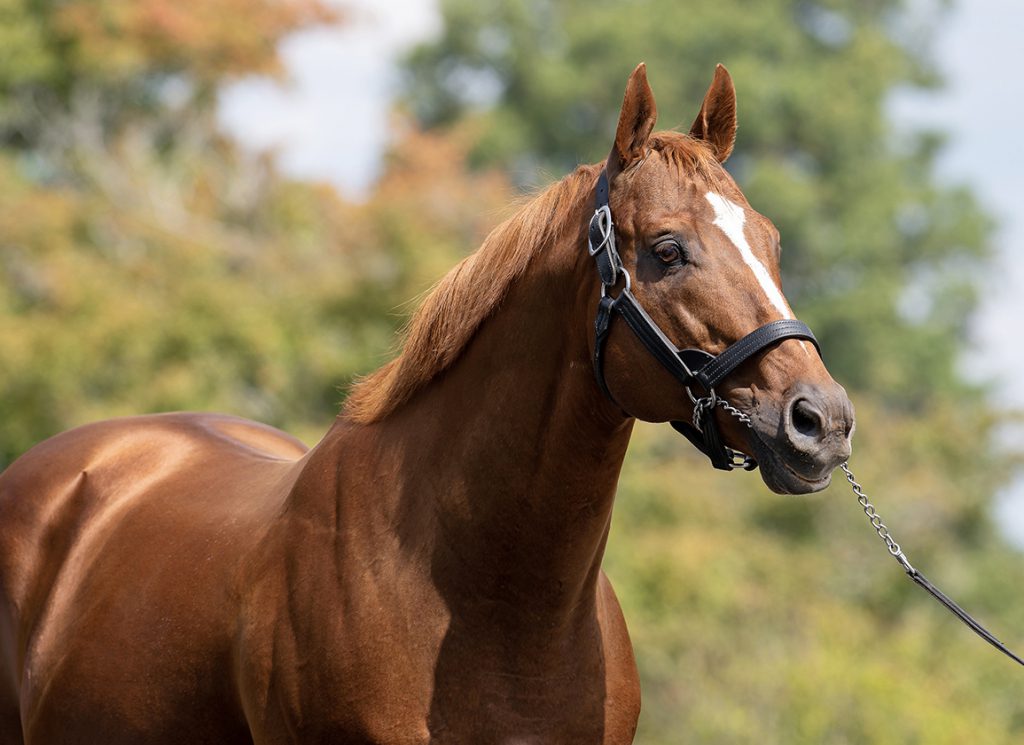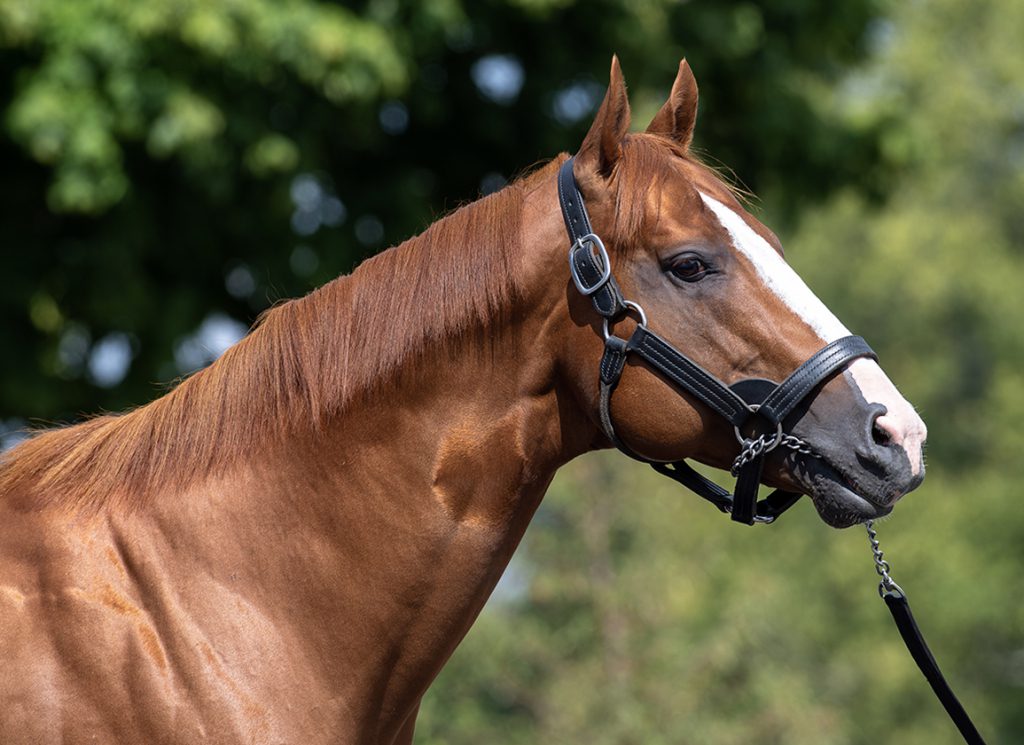Celebrating 40 Years of the Breeders' Cup with Living Legends
There are great racehorses and there are great sires. One doesn't always equal the other. Sometimes, but not always, a horse is equally adept at both.
“It's rare for world-class racehorse to become a world-class sire. It's two different resumes, two different achievements,” said John Sikura, owner of Hill 'n' Dale.
Rarely, ever so rarely, a top racehorse becomes a sire so good and so prolific in generating top-class horses that his own championship race record becomes almost an afterthought. That happened with Northern Dancer. He was a sire in such uncommon air that his own Hall of Fame achievements and Classic wins have been virtually relegated to a footnote amongst the heights of his accomplishments.
Is the same thing happening to 2007 GI Breeders' Cup Classic winner and Hall of Famer Curlin?
When a horse wins the Breeders' Cup, particularly the Classic, that is generally–and rightfully–considered the pinnacle of his or her career. Many are retired shortly afterward as there's a belief they've achieved all they can on the racetrack. A select few might add a second Breeders' Cup win or other Grade I races, but they are always referred to and remembered as a Breeders' Cup winner. Not so with Curlin. His Classic win was merely the launching pad of his impact on the World Championships.
“He's on the cusp of siring the most Breeders' Cup winners ever in different categories, sexes, distances,” said Sikura, who stands Curlin at Hill 'n' Dale. “The uniqueness of him producing world-class horses will be unparalleled in the breed.
“You'd be greedy if you thought the sire you were standing would accomplish this, but Curlin is a force and is unique.”
Indeed, of all the Breeders' Cup winners who have sired Breeders' Cup winners, Curlin ranks only one behind the late Unbridled's Song with five individual winners, making him the leader among living North American sires. A handful of other living sires have matched or exceeded that number–Dubawi (Ire), Into Mischief, and Tapit–but none of them won the Breeders' Cup themselves. Rare air, indeed.
“Any time you've sired more Breeders' Cup champions than any of those horses,” continued Sikura, “it's the highest distinction. What a testament among sires that have sired Breeders' Cup winners. Hopefully we can break the record this year or tie it. He had three winners last year which has never been achieved if you look at all the history of the Breeders' Cup.
“Curlin's accomplishments speak for him. If the ultimate goal with a sire is siring a Breeders' Cup winner and if you've done that more than any other sire, then it doesn't really need a graphic or more explanation. He's the best of the very best, that's what that achievement says.”
When Curlin retired as America's richest racehorse with earnings north of $10 million to stand his initial season in 2009, no one could have logically predicted the dual Horse of the Year's best and biggest contribution to the sport was still ahead.
But one person did. His majority owner, Jess Jackson, told the media in late 2008: “He is one of the best examples of the breed–fast, strong, and durable. I predict he will make a substantial contribution to our sport through his gene pool, and I am looking forward to seeing his foals compete and possibly exceed his unequaled race record.”
Jackson, the late founder with his wife, Barbara Banke, of the then-fledgling Stonestreet Farm, was never shy with bold, sometimes flamboyant statements, but perhaps even he would be floored at the stark truth in his prediction these 15 years later. Curlin, with that gleaming golden coat, has the Midas Touch as a sire. And unlike many stallions, who have their best horses early on with those initial good books of mares, Curlin seems to be getting better and better. In 2022 alone, he became the first sire in the history of the Breeders' Cup to have three winners in one day. More specifically, it was three winners in less than three hours: races 5, 7, and 9.
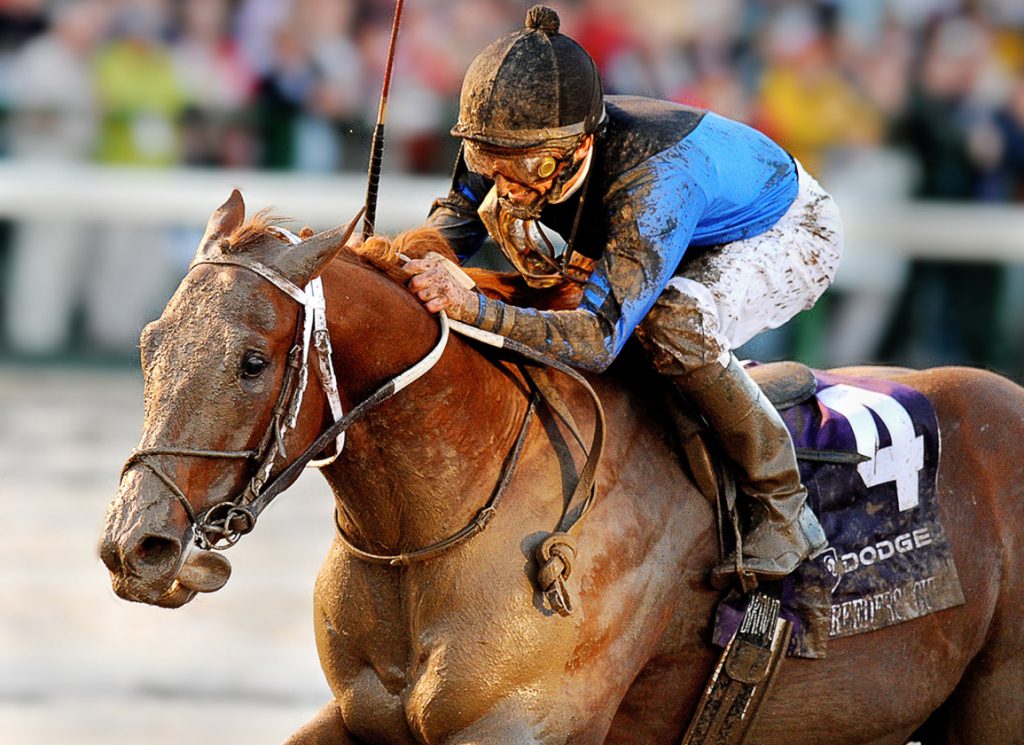
Curlin's Breeders' Cup Classic win | Sarah Andrew/Equi-Photo
Curlin's own Classic in 2007 was a powerhouse performance in a soggy rendition at Monmouth Park. He'd never faced a sloppy track before, but it proved no obstacle. In a foreshadowing of his future, he manhandled his opponents on the racetrack and drew away with authority, just as he would do so on many indicators of the sire charts.
Curlin was Jackson's first major racehorse; Rachel Alexandra (Medaglia d'Oro) would be his second. Incidentally, and perhaps relevant to today's ongoing debate over synthetic surfaces, Curlin's only career off-the-board finish was a fourth when attempting to defend his Breeders' Cup Classic title at Santa Anita in 2008 over the then-synthetic. Jackson publicly stated at the time his horses would never compete over a synthetic surface again. True to his word, the next year, he did not enter Rachel Alexandra in the Breeders' Cup when it returned to Santa Anita despite her undefeated sophomore season which included wins over the boys in the GI Preakness, GI Haskell, and GI Woodward, as well as a 10 1/4-length GI Kentucky Oaks romp.
Jackson passed away in 2011 when Curlin's first foals were still short yearlings. He had been an incredibly sporting owner in his short time at the top level of the sport, proven by his decision to campaign Curlin at age four. Many would have retired the chestnut after a 3-year-old season that included that included wins in the GI Preakness, GI Jockey Club Gold Cup, and Classic, plus a head second to Rags to Riches (A.P. Indy) in an unforgettable GI Belmont S. battle. Curlin rewarded Jackson with another three U.S. Grade I wins at four, as well as a trip around the world to bring back a G1 Dubai World Cup trophy.
“He was the best horse in the world [at that time],” said Sikura. “I think his body of work as a racehorse was special and unique. He's passing on that quality, that ability, that soundness, that tenaciousness. All those things that made him such a great horse he's passing on to his progeny.”
Curlin initially stood at Lane's End upon retirement, but a change in his ownership brought him to Hill 'n' Dale for the 2016 season, when his first crop had completed their 5-year-old campaigns. Stellar Wind would be named the 2015 champion 3-year-old filly, Keen Ice had won the GI Travers S., Palace Malice had captured the GI Belmont S. and the GI Met Mile, and Curalina had taken the GI Acorn S. and GI CCA Oaks–all career-making accomplishments for the majority of sires. But most sires are not Curlin. He was just getting warmed up.
“There was an opportunity we seized upon when a 20% interest arose,” said Sikura. “It was ahead of his ability, but when it arose we certainly did everything to secure him. Look at all the Breeders' Cup winners along the way [since then]. He's done great things and hopefully will consistently continue to do them.”
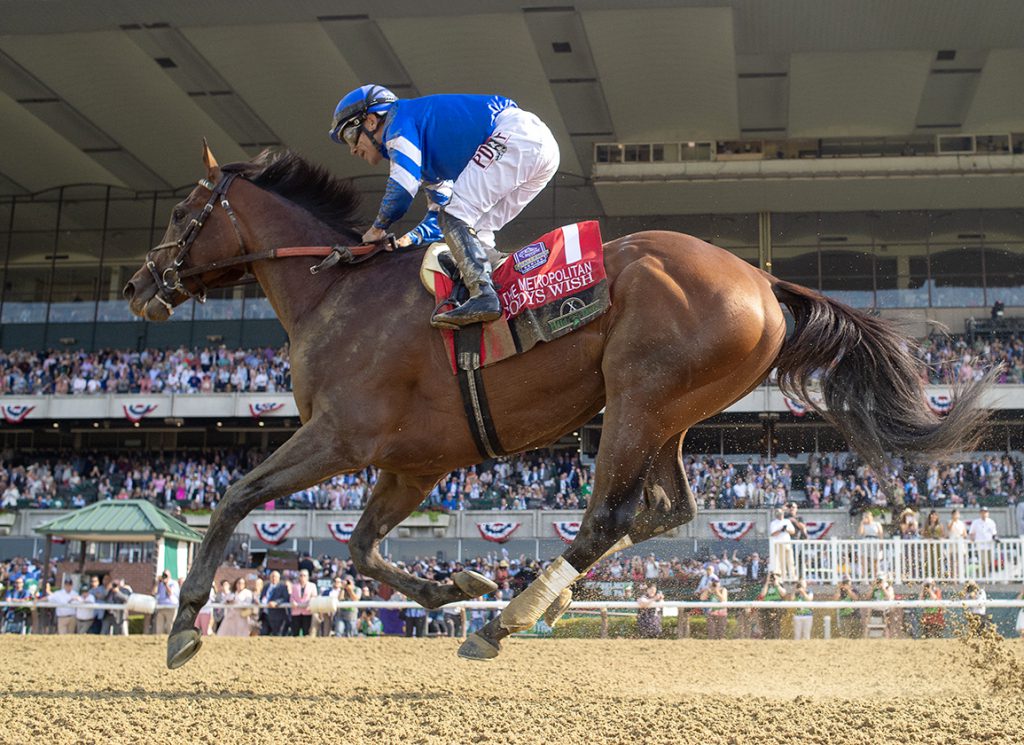
Cody's Wish, shown winning the 2023 Met Mile. After his Saturday score in the Vosburgh, Godolphin's Michael Banahan said, “The major goal was trying to win the Met Mile, which we achieved. Everything else was just bonus to top it off.” | Sarah Andrew
Among Curlin's 21 Grade I winners and/or seven champions are Breeders' Cup winners Vino Rosso (2019 Classic) and Good Magic (2017 Juvenile), as well as his trio in 2022: Malathaat (Distaff), Elite Power (Sprint), and Cody's Wish (Dirt Mile). Amazingly, his runners have had another nine placings in Breeders' Cup races.
“If they make the starting gate, they're dangerous,” said Sikura. “He is multidimensional at the highest level; that's what makes him so special.
“He has done everything but be leading sire by progeny earnings. He's been carefully managed with fewer starters and fewer earners, but more importantly, he's siring more Grade I horses than any other horse during the last few seasons. When he breaks the Breeders' Cup record he can singularly be the horse.”
Sikura is right; by Grade I winners, Curlin currently leads North America's 2023 leading sire list and did in 2021 and 2022 as well.
“He's a horse whose achievements will be seen throughout the history of racing,” continued Sikura. “He's a true classic sire. His accomplishments prove that he is that special and unique horse.”
Sikura believes in Curlin's abilities so much that he did a deal for the breeding rights of Good Magic during that colt's 3-year-old year and now stands him as well. Hill 'n' Dale had consigned Good Magic to the 2016 Keeneland September sale as a yearling for his breeder, Stonestreet. Good Magic brought $1 million and broke his maiden in the Breeders' Cup Juvenile, then went on to have a stellar sophomore season, sandwiching wins in the GII Blue Grass S. and GI Haskell S. around a second in the GI Kentucky Derby.
“He's not quite as coarse as Curlin. He's medium-sized and he moves very well. If he's successful, he reminds you of Curlin. If not, he reminds you of the dam,” said Sikura with a laugh. “He's successful, so Curlin gets that attribution. He has a soundness quality and is probably a little earlier than Curlin was. I see, in the performance of his offspring, some similarities to Curlin, but he has his own ability to transmit those qualities.”
Good Magic leads the second-crop sire list by the standard measurement of earnings and got this year's Kentucky Derby winner, Mage, in his first crop. This marks the second consecutive year one of Curlin's sons has sired the Derby winner, as Keen Ice sired Rich Strike last year. Curlin has four sons to date who have sired Grade I winners.
“It's hard for a stallion to be trending any better than Good Magic. The secret is out,” said SF Bloodstock's Tom Ryan two weeks ago at the Keeneland September sale after purchasing a $700,000 session topper by the son of Curlin. “At this point, when you have a stallion producing horses at that elite level, the price bracket can get to an elite range as well. At the end of the day, you try to buy them as reasonably as possible, but it's our job to buy them.”
Curlin himself had two of the seven-figure yearlings at that sale and another two at the Fasig-Tipton Saratoga sale, including the $4-million topper out of champion Beholder (Henny Hughes). Despite a few more yearling sales remaining on the 2023 calendar, that Curlin yearling is likely to be the highest-priced yearling of the year.
“Everyone has given their best to the horse and he has rewarded that faith and opportunity by giving his best,” said Sikura. “Quid pro quo: we give our best, he gives his best. That's rewarding.”
Sikura pointed to the support of Stonestreet as one of the keys to getting Curlin those opportunities.
“Stonestreet has been great supporters. They were active in supplying those great mares ahead of the marketplace. That's a reward in itself and now other people are emulating that. There's synergy between owner and horse. They have that belief in him.”
Curlin's 12th crop of 2-year-olds is at the races this year. No fewer than 16% of all his foals aged three and up are stakes performers. If one looks only at starters, the number jumps to a provocative 20%. Curlin has 97 black-type winners bred in this hemisphere; 55 of those are graded winners; 21 are Grade I winners; seven are champions. Heady numbers, indeed. And he's showing no sign of slowing down.
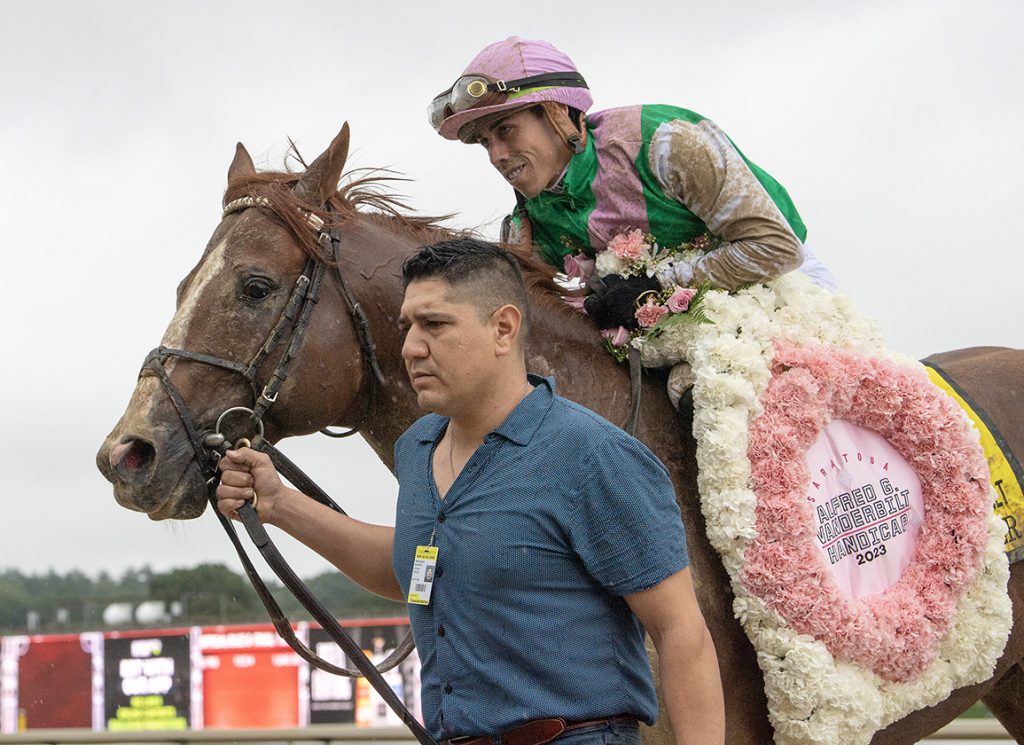
Another of Curlin's 2022 Breeders' Cup winners, Elite Power, has come back to be a repeat Grade I winner in 2023. Curlin has five Grade I winners this year, top in the nation. | Sarah Andrew
“He's doing fantastic,” said Sikura. “He's a 19-year-old horse and is very, very fertile. He continues to sire elite-level horses. When the market looks at stallions when they get middle-aged, it is receptive if they are still performing. He is current and popular at the racetrack with representation and performance at the highest levels every year.”
From Breeders' Cup winner to Breeders' Cup sire, Curlin can no longer be considered on the cusp of greatness. He hurdled that superlative long ago. Perhaps an avalanche is a better term to describe his momentum as he sweeps up and overwhelms everything in his path, but he leaves things improved, not bereft as an avalanche does. He may not be Northern Dancer yet, but don't count him out.
“He is a self-made man. He brought just $57,000 as a yearling, but he's overcome every prejudice and at every opportunity he continues to elevate. That proves how great he is. We can just nod our head to that greatness level,” said Sikura.
Northern Dancer himself was famously an unsold yearling before his Hall of Fame racing career and unprecedented success as a sire. Curlin may have sold as a yearling for what now looks to be the bargain of the century, but he, too, was inducted to the Hall of Fame and is certainly proving himself as a sire and a burgeoning sire of sires. It's early days yet for him as a broodmare sire, but there's already 15 black-type winners and seven graded winners out of his first daughters.
Curlin knows he's special.
“He's like a politician. When someone shows up, he has a big smile because he knows he's going to get his picture taken,” said Sikura. “He has that aura about him, that life force. He knows he's the dominant male. He's not a fractious horse, doesn't bounce around, just looks around like 'I own the place.' Well, I own the place, but he paid for it. He's my best banker.”

The post Curlin, from Breeders’ Cup Winner to Breeders’ Cup Sire appeared first on TDN | Thoroughbred Daily News | Horse Racing News, Results and Video | Thoroughbred Breeding and Auctions.
Source of original post
